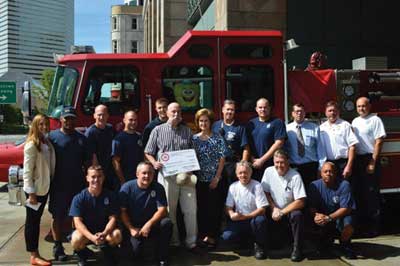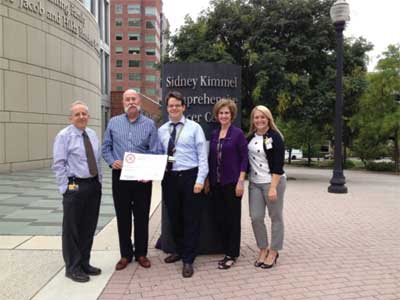The Retired Professional Fire Fighters Cancer Fund (RPFFCF) recently made two donations to established promising cancer research programs. According to William H. Newland, RPFFCF president, the organization donates to areas of research dedicated to the types of cancer that have higher incidences for firefighters than the general population.
The Bladder Cancer Research Program at Dana-Farber Cancer Institute in Boston, Massachusetts, received a $10,000 donation, which was presented at the Boston (MA) Fire Department’s Division 1 headquarters (photo 1). A $10,000 check was awarded also to the Brain Cancer Research Program at Johns Hopkins’ Sidney Kimmel Comprehensive Cancer Center in Baltimore, Maryland (photo 2).
 |
| (1) (Center): William H. Newland and Tricia Newland, RPFFCF secretary of the Fire Fighters Cancer Fund; (far left) Kathleen Sullivan, assistant director of development at Dana-Farber; and on-duty personnel of Boston Fire Department’s Rescue 1, Engine 10, and Ladder 3. |
 |
| (2) (L to R): Dr. Stuart Grossman, cancer researcher at Johns Hopkins; Newland, RPFFCF president; Dr. Matthias Holdhoff, cancer researcher at Johns Hopkins; Tricia Newland, RPFFCF secretary; and Megan LeDonne, assistant director of development at Johns Hopkins. |
In the past year, the RPFFCF raised and donated $75,000 to established and promising cancer research programs across North America. No one involved with the nonprofit 501(c)3 organization receives any salary or stipend. Additional information is available at www.letsfirecancer.org.
|
|
September 22. Firefighter Iran D. Rivers, 48, Hillsborough County Fire-Rescue, Tampa, FL: found deceased in quarters; cause not yet known. Source: USFA Firefighters Memorial Database |
Ontario, Canada, adopts NFPA Pro-Qual Standards in 2014
Ontario, Canada, will transition from the Ontario Fire Service Standards to the National Fire Protection Association (NFPA) Pro-Qual Standards in 2014. Ontario firefighters will be able to achieve National Board of Fire Service Professional Qualifications (Pro Board) certification.
The Pro Board, created in 1990, is a mechanism for acknowledging internationally professional achievement in the fire service and related fields. Its members use NFPA professional qualification standards to develop training programs for uniform members of career and volunteer public fire departments. Graduates are Pro Board certified in a particular skill.
NFPA Pro-Qual standards will recognize job experience, education, and work completed in the Ontario Fire College diploma programs. They meet the requirements of the governing legislation of Ontario, the Fire Protection and Prevention Act of 1997.
Bucket Brigade grants $270,000 to departments
Georgia-Pacific Bucket Brigade has hit the $1.25 million mark in cash grants awarded to fire departments that serve Georgia-Pacific facility communities in the United States. The company awarded a total of $270,000 to 55 fire departments this year, the largest annual amount since the program began in 2006. The departments will purchase urgently needed equipment.
The grants ranged from $1,000 to $10,000 and were awarded on the basis of need. This year’s applicants requested funds to replace worn-out personal protective clothing, cracked helmets, aging hoses and nozzles, and hand-held radios.
Georgia-Pacific has partnered with the National Volunteer Fire Council (NVFC) since 2008 to increase awareness about the grant program. All grant applicants also are awarded NVFC memberships.
The recipients of this year’s grants represent 21 states. The awards were made in conjunction with National Fire Prevention Week, Oct. 6-12, according to the National Fire Protection Association. For information on the Georgia-Pacific Bucket Brigade program, go to http://www.gp.com/aboutus/bucketbrigade/index.html.
May 3, 2014, NFPA Wildfire Community Preparedness Day
The first National Fire Protection Association (NFPA) National Wildfire Community Preparedness Day (Wildfire Preparedness Day) will be held on Saturday, May 3, 2014. Activities for this event may run for the entire day or any part of a day and may be sponsored by individuals or groups. Examples of projects include the following: hosting a chipping day, distributing wildfire safety information to neighbors, and organizing brush cleanup. A list of ideas for projects is at www.nfpa.org/wildfirepreparednessday.
Communities across the country are urged to take part in projects that will help decrease the risk of wildfires. According to the National Interagency Fire Center, so far this year, more than 65,000 wildfires burned more than nine million acres in the United States.
Communities officially recognized through the Firewise Communities/USA® Recognition Program can credit participation on National Wildfire Preparedness Day toward their 2014 “Firewise Day” event.
NFPA reports on 2012 fire losses
The National Fire Protection Association (NFPA), in its report “Fire Loss in the United States During 2012,” advised that there were 2,855 civilian fire fatalities; 16,500 civilian fire injuries; and an estimated $12,427 billion in direct property loss. Home fires caused 2,380 civilian fire deaths.
Of the 2,855 civilian fire casualties in 2012, 2,405 were in residential structures, 65 were in nonresidential structures, and 385 were in fires outside of structures.
Seventeen of these incidents were “catastrophic multiple-death” events-fires or explosions in homes or apartments that resulted in five or more fire-related deaths or in all other structures and outside of structures, such as wildfires and vehicle fires, that claimed three or more lives.
These 17 fires killed 82 people, including 16 children under the age of six, who perished in residential properties. In 2011, there were 24 catastrophic multiple-death fires that resulted in 117 deaths; 16 were children under the age of six. Eight of the fires were in residential structures (44 deaths), two were in nonresidential structures (seven deaths), and seven were nonstructure fires (31 deaths).
Prevent Tragedy: Focus on Behavioral Health
BY THE NATIONAL VOLUNTEER FIRE COUNCIL
Behavioral health is a subject not often talked about in the fire service, but it affects every department and emergency responder in some way or other. In a culture where members frequently brush aside how they are feeling, this is a hard subject to tackle. Yet, behavioral health issues are just as serious as physical health and safety issues and can be just as deadly if left unaddressed.
Behavioral health can cover a wide spectrum of health issues for firefighters and emergency responders. They can include stress or anxiety, sleep problems, depression, post-traumatic stress disorder, and addiction, to name a few effects. If left untreated, many of these issues could result in serious or life-threatening physical health disorders, such as heart attack or high blood pressure. Some could also lead to safety concerns as firefighters are less prepared to do their jobs safely and to the best of their ability if they are battling one or more of these issues. In many instances, untreated psychological conditions could lead to firefighter suicide-a tragedy for the firefighters, their families, their departments, and the entire fire service community.
Firefighters and EMTs respond to the worst crises-fires, traffic accidents, abuse, shootings, and more. At the same time, they are balancing the needs of the fire department; their families; other outside interests; and, in the case of volunteers, full-time jobs. Add to the mix unpredictable sleep schedules, the potential for unhealthy eating habits, lack of time for proper fitness, and a culture where talking about one’s feelings or difficulties may not be accepted, and it is no wonder that emergency responders have an increased risk for one or more behavioral health concerns.
What Can We Do?
It is critically important that department leadership make behavioral health as much of a priority in the department as physical health and safety. Having resources available to firefighters and EMTs who need help, creating a culture where talking about issues is encouraged, and breaking the stigma associated with behavioral health issues can provide the support a firefighter needs to seek treatment and prevent tragic outcomes such as suicide.
Mandatory behavioral health training is a critical first step in adopting a proactive approach within the department. Having effective retirement planning procedures in place is also important, as many firefighters suffer from stress, depression, loss of identity, or other negative effects when faced with leaving the fire service after dedicating their lives to it.
Other proactive measures include having an Employee Assistance Program available to all department members, having workshops where counselors or other qualified entities (CISM teams, chaplains, training officers) address potential issues and how to recognize signs and symptoms of distress, and encouraging all fire academies to include at least four hours of behavioral health training for cadets.
RESOURCES AVAILABLE
In recent years, the fire service has become aware of how serious behavioral health issues are for emergency responders. The Firefighter Behavioral Health Alliance (www.ffbha.org) has collected information on 375 firefighters and 18 EMTs/paramedics who have committed suicide. Departments have also begun to notice the wide range of negative outcomes that can result from ignoring behavioral health.
Fortunately, many resources are available to help departments and individuals address these issues and prevent potential negative outcomes. The pull-out poster in this issue of Fire Engineering can be put up at the station to remind personnel of the importance of seeking help and what they can do.
• National Fire Services Member Assistance Program-www.nvfc.org/help. This toll-free hotline is available to all firefighters, EMS personnel, and their families who need immediate assistance with any problems affecting work or personal life, such as stress, depression, alcohol or drug addiction, financial management difficulties, critical incidents, relationship problems, work-related concerns, and more. Trained firefighters and counselors familiar with the fire and emergency services are available 24/7. Call 1-888-731-FIRE (3473) for help.
• Firefighter Life Safety Initiative 13, Behavioral Health-http://flsi13.everyonegoeshome.com.
Initiative 13 of the National Fallen Firefighters Foundation’s Life Safety Initiatives focuses on the psychological well-being of firefighters and their families. The new Initiative 13 Web site contains important resources, training, and research, including the new model for exposure to potentially traumatic events and stress aid for fire and EMS personnel, which recognizes that not everyone responds the same to traumatic events.
• Suicide in the Fire and Emergency Services: Adopting a Proactive Approach to Behavioral Health Awareness and Suicide Prevention-www.nvfc.org/hot-topics/health-resources. This report from the National Volunteer Fire Council explores the various behavioral health concerns first responders face and identifies resources and best practices for mental wellness and suicide prevention.
• Preventing and Coping with Suicide in the Fire and Emergency Services-https://nvfc.digitalchalk.com. The National Volunteer Fire Council, with support from the U.S. Fire Administration, developed this online training course focusing on suicide awareness and prevention. The course contains three modules that examine the signs and symptoms preceding suicide, highlights available resources for departments and individuals, and discusses the healing process when coping with a firefighter suicide. New students must create an account before registering for the course.
• Behavioral Health Resources-www.safetyandhealthweek.org/resources/behavioral-health-resources. The focus of the 2013 International Fire/EMS Safety and Health Week was behavioral health. This Web site provides a lengthy resource and training listing to help firefighters and their departments focus on behavioral health and well-being.
Fire Engineering Archives


